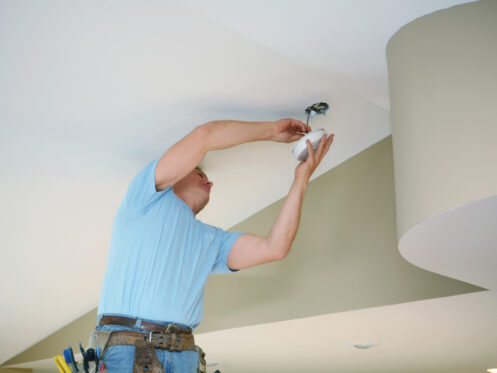Carbon monoxide (CO) is a poisonous gas that can cause death at high levels of exposure. According to the Centers for Disease Control (CDC), over 400 Americans die each year from CO poisoning unrelated to fires. In addition, more than 100,000 U.S. residents rush to the emergency room for CO poisoning, and over 14,000 Americans are hospitalized due to carbon monoxide exposure. Although carbon monoxide can result from any machine or appliance that burns fuel, leaks inside the home can also lead to unexpected increases. A look at the top warning signs your house may have a carbon monoxide leak can help you safeguard your family against this dangerous occurrence.
What Is Carbon Monoxide?
Carbon monoxide is a colorless, odorless, and tasteless gas that results from the incomplete combustion of fuel. It is toxic and highly flammable. According to the Environmental Protection Association (EPA), carbon monoxide consists of a single carbon atom and a single oxygen atom held together with a triple bond. Whenever there is incomplete oxidation of carbon during combustion, carbon monoxide is the result. Unfortunately, it is dangerous for any mammal to continuously inhale the carbon monoxide molecule.
Any kind of fuel that burns can produce carbon monoxide. These types of fuel include gasoline, oil, kerosene, propane, fireplace wood, and charcoal. Carbon monoxide exposure can also result from undetected natural gas leaks inside of the home.
Common household sources of carbon monoxide and gas leaks include the following:
- Natural gas appliances like furnaces, ovens, or stoves
- Gas-powered lawn mowers or power tools
- Fireplaces or wood-burning stoves
- Space heaters or oil-burning lanterns
- Charcoal grills or coal stoves
- Water heaters
- Gas-powered laundry units
What Is Carbon Monoxide Poisoning?
Carbon monoxide poisoning occurs when excessive amounts of CO enter the bloodstream. Once inhaled, carbon monoxide attaches to the hemoglobin in red blood cells. Hemoglobin is a protein responsible for delivering oxygen to vital organs and tissues throughout the body. When CO attaches to the hemoglobin, it blocks the protein’s ability to carry and transport oxygen. Consequently, organs like the brain, heart, lungs, and other important tissues suffer from a lack of life-giving oxygen. Carbon monoxide poisoning can lead to serious injury and coma. The most extreme cases of poisoning can lead to death. In addition, the poisoning rate can occur faster in tightly enclosed spaces that lack ventilation. This poison is called the “silent killer” since exposure can cause brain injury or death before anyone realizes there is a problem.
What Are the Signs of a Carbon Monoxide Leak in the Home?
While carbon monoxide leaks are hard to detect in many ways, there are several warning signs that you should never ignore. These signs include the presence of exhaust, defective pilot lights, soot buildup, stains around major appliances, and telltale health symptoms.
1. Odors Like Rotten Eggs or Exhaust Gas
While carbon monoxide itself is odorless, a leak means that you may smell the odor of chemicals or exhaust gases that accompany it. For example, the smell of sulfur or rotten eggs often signifies a natural gas leak in the home. Natural gas leaks can lead to carbon monoxide poisoning. By law, natural gas companies add a chemical known as mercaptan to natural gas as a safety feature. Mercaptan has a sulfuric or rotten-egg odor designed to alert you that it is time to evacuate the home. In addition to the sulfuric odor, you may also smell exhaust odors or burning smells in the event of a leak. This can happen if the leak comes from the burner of one of your gas-powered or oil-fueled appliances. Directly outside the home, you might smell a car exhaust or traffic smell. This can occur if the leak comes from your home’s backup generator or gas-powered lawn tools.
2. Flickering Pilot Lights
The pilot light is an ignition source for gas-powered appliances. When the pilot light is working correctly, it displays a steady blue flame. However, a flickering or dull-yellow flame can indicate a defective pilot light. The failure of this ignitor can subject your home to an unhealthy flow of carbon monoxide gas. Contact a home services company for repairs and assistance.
3. Increased Soot Buildup
All fuel-burning appliances need proper ventilation that allows trace amounts of carbon monoxide to escape from your home. Depending on the appliance or the structure, this vent is called a flue pipe or exhaust pipe. For example, gas stoves have exhaust vents and a wood-burning fireplace has the chimney flue. If you notice dark-colored soot buildup around vents, however, this is often a sign of poor ventilation and increased exposure to carbon monoxide. Reach out to a professional for inspections and help.
4. Stains Around Appliances
Leaking or malfunctioning gas lines can cause a buildup of brownish-yellow stains around the home. If you notice unexplained stains around vents or gas-powered appliances, you may have a carbon monoxide leak. Stop using appliances with these stains and call a professional to test the device or check for gas leaks.
5. Flu-Like Symptoms
Prolonged exposure to carbon monoxide can lead to illness. Most people describe the feeling as “flu-like” but without the fever. Symptoms of CO exposure include the following:
- Headaches
- Nausea or vomiting
- Dizziness, confusion, or disorientation
- Shortness of breath
- Muscle weakness
- Impaired vision or coordination
- Sleepiness or loss of consciousness
Although children and the elderly are highly vulnerable to CO, these flu-like symptoms can also occur in healthy adults. If everyone in your household is experiencing these symptoms, seek medical assistance and allow a professional to check your home for carbon monoxide leaks.
What Can I Do To Protect My Family From Carbon Monoxide Leaks?
The most important way to protect your family is to install carbon monoxide detectors and allow experts to test these alarms during routine maintenance checkups. Carbon monoxide alarms detect dangerous levels of this gas and emit alerts so that your family can evacuate the home. Ask your home services professional about interconnected alarms that all activate as soon as one detects the presence of carbon monoxide.
In addition to installing carbon monoxide alarms, you also need to schedule annual maintenance with a home services company. This allows a qualified technician to service your heating system, water heater, and any other fuel-burning appliance each year. The technician can also help ensure that appliances have the right amount of ventilation. If you need to replace any units, the technician can also help you pick the right appliances. For example, you may need to select ENERGY STAR appliances for increased efficiency or equipment bearing the seal of a national testing agency like Underwriters Laboratories (UL).
Get Help From the Experts Today
A carbon monoxide leak poses a serious health and safety risk to your family. Fortunately, the experts are here to help. Sheldon's Heating & Air Conditioning offers services for homes in Riverside, CA and surrounding areas. We install carbon monoxide alarms and conduct routine testing. Our technicians also perform heater installations, inspections, and repairs. We can upgrade your home with high-efficiency furnaces as well as check any water heaters or boilers. Our technicians also service heat pumps and can maintain ductwork or ductless mini-splits. No matter the HVAC issue, we can help. Contact Sheldon's Heating & Air Conditioning today for all home services needs.




